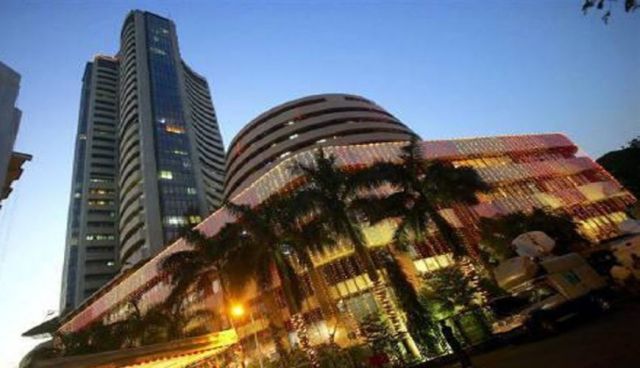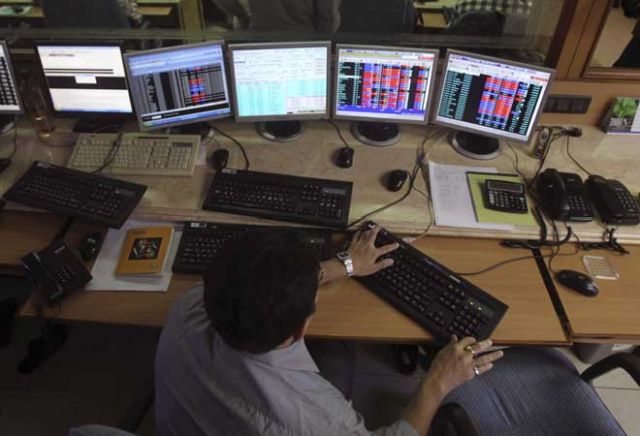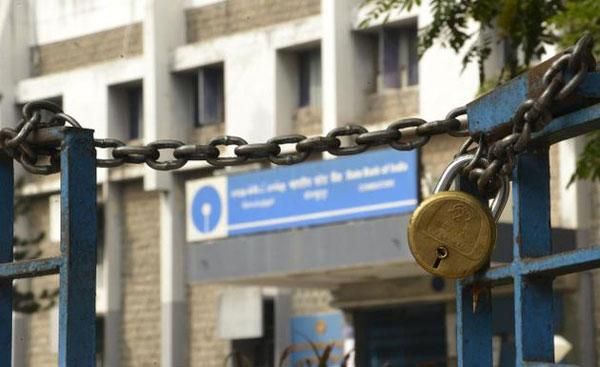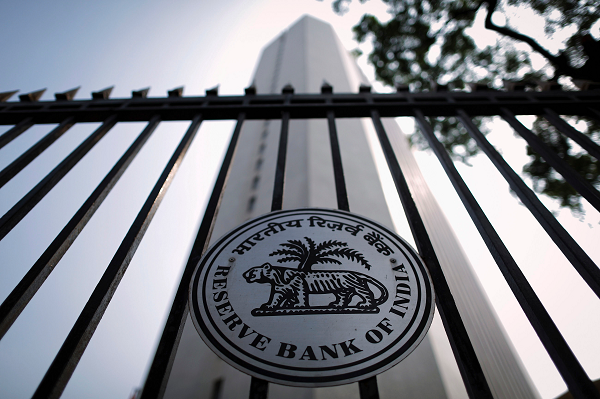
by admin | May 25, 2021 | Banking, Economy, Markets, News
 By Rohit Vaid,
By Rohit Vaid,
Mumbai : The Reserve Bank of India’s (RBI) second monetary policy review for 2018-19, combined with the direction of foreign fund flows and global crude oil prices are expected to set the course for the key equity indices in the coming week.
Market participants will follow the monsoon’s progress and the rupee’s movement against the US dollar for further cues, analysts opined.
“With the earnings season almost coming to an end, the markets next week would look forward to the RBIs monetary policy,” Devendra Nevgi, Founder and Principal Partner, Delta Global Partners, told IANS.
The Monetary Policy Committee (MPC) of the RBI is slated to meet from June 4 to 6 for the second bi-monthly monetary policy statement for 2018-19.
In its last review, the country’s central bank had maintained the status quo on its key short-term lending rate at 6 per cent, along with its “neutral” stance.
“Given the higher GDP growth rate released last week, the chances of a policy rate hike has risen, though not assured, as RBI would take a wait-and-watch approach,” Nevgi said.
“A rate hike, if it comes accompanied by hawkish policy language, would hit the market sentiment, especially the banks and the NBFCs.”
According to SMC Investments and Advisors’ Chairman and Managing Director D.K. Aggarwal: “Now markets across the globe are closely watching each development regarding US trade policy, Italy ‘s politics and the dynamics unfolding in the global crude market.”
The National Stock Exchange’s (NSE) 50-share “Nifty is expected to move in the range of 10,500-10,900 levels and Bank Nifty is expected to trade between 26,300-27,200 levels”, he added.
Besides, fluctuations in global crude oil prices, along with the movement of Indian rupee against the US dollar and the composite PMI data will also affect investor sentiments.
On a weekly basis, the rupee strengthened by 72 paise to close at 67.06 against the US dollar from its previous week’s close of 67.78 per greenback.
In terms of investments, provisional figures from the stock exchanges showed that foreign institutional investors (FIIs) sold scrips worth Rs 2,707.41 crore during the last trade week.
Figures from the National Securities Depository (NSDL) revealed that foreign portfolio investors (FPIs) divested equities worth Rs 2,756.63 crore, or $405.08 million, during the week ended June 1.
As per the technical charts, the underlying trend of NSE Nifty50 remains bullish.
“Technically, the Nifty seems to have taken a breather after two sessions of gains,” said Deepak Jasani, Head of Retail Research for HDFC Securities.
“With the underlying trend remaining up, the bulls seem to have an upper hand for the coming week. Further upsides are likely once the immediate resistances of 10,765 points are taken out. Crucial supports to watch for any weakness are at 10,620 points level.”
Last week, both the key Indian equity indices — S&P Bombay Stock Exchange (BSE) Sensex and NSE Nifty50 — edged higher on the back of a healthy improvement in the country’s GDP growth rate, along with predictions of a normal monsoon and easing crude oil prices.
Consequently, the barometer 30-scrip Sensitive Index (Sensex) of the BSE rose by 302.39 points or 0.87 per cent to 35,227.26 points.
Similarly, the wider Nifty50 of the NSE closed the week’s trade at 10,696.20 points — up 91.05 points or 0.86 per cent — from its previous close.
(Rohit Vaid can be contacted at rohit.v@ians.in)
—IANS

by admin | May 25, 2021 | Opinions
 By Taponeel Mukherjee,
By Taponeel Mukherjee,
The decision by the Reserve Bank of India (RBI) to grant banks the option to spread provisioning equally over up to four quarters for mark-to-market (MTM) losses on investments is one that merits discussion.
These investments are those held in Available for Sale (AFS) and Held for Trading (HFT) accounts for the quarters ended December 31, 2017, and March 31, 2018. This step has been taken to assist the banks in dealing with declining profits from both the rise in yields on government securities in the past few months and Non-Performing Assets (NPAs).
While in the short run such a step might assist in alleviating the pain in the banking system, in the long run, it needs to move towards creating a more robust framework based on stringent MTM regulations. We need to enforce MTM clauses on financial institutions such as banks with regards to securities across the spectrum, including loans and not just bonds.
Situations that allow banks to spread losses and display profits up front may encourage poor risk-taking by the banks and should be discouraged. The “Held to Maturity” accounts with the banks have the requisite bond holdings that they can hold to maturity without having to account for MTM valuations.
Banks should not assume that they can indulge in trading strategies to show upside immediately and show downside gradually. Instead what the banking system requires now are accountability and transparency. We are sure the RBI has thought through this temporary policy change. However, it should be made clear to the banks that it will not grant them such relief on a regular basis.
In the broader macro-economic picture, it is crucial for banks to brace themselves for a period of increasing interest rate volatility. As global interest rates move higher, bond yields in India will reflect the global volatility to some extent. Market participants should not expect regulatory changes to shield them from market volatility in financial instruments they hold for trading accounts. Banks need to account for the increased volatility in their pricing, risk limits and risk management and not expect the central bank to bail them out of stressful situations.
Given the growth of the Indian economy and the increased importance of the country in the global economic system, banks will have a crucial role to play as facilitators of trade and business. It is essential that they prepare themselves to face global macro-economics-driven volatility through robust internal mechanisms that help them both mitigate and manage risks such as rising bond yields on government securities.
In addition to MTM valuations for the bond market, India needs to push for such valuations of bank loans going forward. The policymakers need to come up with a framework that allows for bank loans to be regularly valued, hence pricing in credit quality gradually.
A framework for MTM valuations for bank loans would require a central agency to create indices for loans based on commonly shared information from the banks based on actual loan repayment information. All bank loans would have to be marked against this index, hence ensuring transparent valuation.
Eventually, the aim would be to develop a robust and functional secondary market for corporate loans, to provide correct pricing and management of risk. A functional secondary market would eliminate information asymmetry from the system such as in the US loan market, an excellent template from which to learn.
India should learn a few lessons from the Japanese Banking crisis of the 1990s. Poor lending combined with delayed recognition of losses ended up creating “zombie banks” in Japan. The economic and social implications of a poorly functioning banking system was there for everyone to see as Japan struggled to regain growth rate of the past decades.
It is essential that the banking system adheres to strict regulations around transparency. A transparent banking system assists in higher lending standards and better dissemination of information regarding corporate credit quality. The Indian banking system must make strides towards greater transparency so as to provide an efficient system that is so essential for economic growth.
(Taponeel Mukherjee heads Development Tracks, an infrastructure advisory firm. The views expressed are personal. He can be contact at taponeel.mukherjee@development-tracks.com or @Taponeel on Twitter)
—IANS

by admin | May 25, 2021 | Banking, Corporate, Corporate finance, Economy, Markets, News
 New Delhi : Welcoming the RBI’s move to explore introduction of an official virtual currency in India, industry chamber Assocham on Sunday cautioned that extreme care be taken to ensure safety of the data trail that cryptocurrency transactions can leave behind.
New Delhi : Welcoming the RBI’s move to explore introduction of an official virtual currency in India, industry chamber Assocham on Sunday cautioned that extreme care be taken to ensure safety of the data trail that cryptocurrency transactions can leave behind.
Placing a ban on all regulated entities, including banks, from dealing in virtual currencies like bitcoins, the Reserve Bank of India said on Thursday that it is exploring a “fiat digital currency”.
“Of course the inter-departmental study group of the RBI would examine all the safety aspects when it starts working on exploration of the cryptocurrency which has been introduced by private parties in several parts of the world and has attracted a lot of attention,” an Assocham release said here.
“The need for safety is highlighted more by the recent and serious incidents of breach of the Facebook data of as many as 87 million users all over the world,” the release said.
The industry body said that “it is quite pragmatic and courageous of the RBI to initiate exploratory steps towards the world of virtual currencies”.
“A high level of coordination among all the central banks would be required along setting up some kind of a global oversight to guard against misuse of the new currency by the anti-social elements, terrorists, enemy countries,” it said.
“We cannot isolate ourselves from the ever rising number of technology platforms. Each and every individual who would be using the virtual currency must be protected against fraud, data leak, etc.”, Assocham Secretary General D.S. Rawat said.
“Needless to say, the liability of the RBI as is the case with the hard currency would be clearly defined in the case of virtual currencies,” he added.
Briefing reporters earlier this week in Mumbai, RBI Deputy Governor B.P. Kanungo said regulated entities already providing services to any individual or business dealing in digital currencies have been given three months to exit the relationship.
Noting, however, the benefits that blockchain technology, which underlies cryptocurrencies, can potentially bring for financial inclusion and in increasing financial system efficiency, Kanungo said the central bank is exploring a “fiat digital currency”.
“Several central banks are debating the possibility of introducing a fiat digital currency as opposed to the private digital tokens. These, issued by the central bank, are considered its own liability,” he said.
“They will be in circulation in addition to the paper currency and also hold the promise of reducing the cost of printing of notes,” he added.
According to investigation agencies here, with the demand and price of cryptocurrencies on the rise, cyber criminals have found innovative ways to dupe those looking to invest.
Bitcoins in India have been trading at more than Rs 10 lakh each, while people are investing amounts ranging from Rs 3,000 to several lakhs of rupees.
—IANS

by admin | May 25, 2021 | Banking, Economy, Markets, News
 By Porisma P. Gogoi,
By Porisma P. Gogoi,
Mumbai : The Indian equity market, which will resume trade on Monday after a four-day-long break, will track domestic events like the central bank’s first bi-monthly monetary policy review for the 2018-19 financial year, along with the release of macro-economic and automobile sales data, for direction in the upcoming week.
Along with domestic factors, global market sentiment, as well as crude oil prices and the course of foreign and domestic funds are also expected to influence investors’ risk-taking appetite during the week ahead.
“Next week will be the commencement of the new financial year after the long weekend and markets would look forward to the PMI (Purchasing Managers’ Index) numbers. The Reserve Bank of India (RBI) monetary policy committee meeting is scheduled on Thursday,” Devendra Nevgi, Founder and Principal Partner, Delta Global Partners, told IANS.
According to Nevgi, markets are not expecting any action from RBI in terms of changes in policy rate, but the language would be scrutinised closely to ascertain its stance.
Macro-data scheduled to be released next week include the Nikkei India PMI data for the manufacturing sector on Monday and for services sector on Wednesday.
“The response of banks to the commencement of India’s borrowing programme remains the key for interest rates. The global sentiments, especially towards technology stocks in the US, remain important. The fall in interest rates in the US (10 year) as well as in India should help the sentiment,” he added.
Last week, the Central government’s decision to borrow only Rs 2.88 lakh crore through its benchmark bond scheme in the first half of FY19 — 47.5 per cent of the total budgeted amount — as against 60-65 per cent share in this period in previous years, had lifted investors’ sentiments.
Also, positive global cues on the back of trade war fears easing between major world economies had pulled the key Indian equity indices from their five-month lows to close with substantial gains.
On a weekly basis, the barometer 30-scrip Sensitive Index (Sensex) of the Bombay Stock Exchange (BSE) closed at 32,968.68 points — gaining 372.14 points or 1.14 per cent — while the wider Nifty50 of the National Stock Exchange (NSE) closed trade at 10,113.70 points — up 115.65 points or 1.16 per cent from its previous week’s close.
D.K. Aggarwal, Chairman and Managing Director of SMC Investments and Advisors, said that, apart from the outcome of the RBI monetary policy meet and macro-economic data, the trend in the global markets will also set the course for the domestic bourses next week.
“The trend in the global markets, investment by foreign portfolio investors (FPIs) and domestic institutional investors (DIIs), the movement of the rupee against the dollar and crude oil price movement will dictate the trend of the market,” Aggarwal told IANS.
Last week, the Indian rupee weakened by 17 paise to close at 65.18 against the US dollar from its previous week’s close at 65.01.
Provisional figures from the stock exchanges showed that foreign institutional investors (FIIs) sold scrips worth Rs 868.62 crore, while the DIIs purchased stocks worth Rs 6,151.53 crore during the truncated trade week.
Figures from the National Securities Depository revealed that FPIs invested in equities worth Rs 3,214.27 crore, or $494.08 million, during March 26-28.
In the upcoming week, initial sentiments in market trading will be driven by global clues and the on-going ICICI Bank crisis, said Gaurav Jain, Director at Hem Securities.
“Eventually, all focus will shift to the RBI policy. We will also see some stock-specific action on account of a rejig in the Nifty50 index. Bajaj Finserv, Grasim Industries and Titan Company will replace Ambuja Cements, Aurobindo Pharma and Bosch in the Nifty50 index from Monday,” said Jain.
“Beside the RBI policy, auto stocks will be in focus as the auto companies start announcing monthly sales numbers for March 2018 starting from April 1,” he added.
Deepak Jasani, Head of Retail Research for HDFC Securities, maintained that on technical levels, the Nifty50 remained in a downtrend for the week ahead.
“Technically, the Nifty remains in downtrend and further downsides are likely early next week once the immediate support of 9,958 is broken,” Jasani told IANS.
“Immediate resistance is now at 10,228,” he added.
(Porisma P. Gogoi can be contacted at porisma.g@ians.in)
—IANS

by admin | May 25, 2021 | Banking, Corporate, Corporate finance, Corporate Governance, News, Politics
 Mumbai : The Reserve Bank of India (RBI) has announced special measures for transaction of central and state government business by banks handling government accounts on March 31 in view of the closing of the financial year on that day.
Mumbai : The Reserve Bank of India (RBI) has announced special measures for transaction of central and state government business by banks handling government accounts on March 31 in view of the closing of the financial year on that day.
In a release late on Tuesday, the RBI also said special arrangements have been made to conduct special clearing operations on March 31 in order to facilitate government receipts and payments.
“With a view to providing greater convenience to tax payers, it has been decided that RBI offices and all designated branches of agency banks conducting government banking will keep their counters open up to 8.00 p.m. on March 31, 2018.
“Electronic transactions can be done till the midnight of that day,” it said.
“To facilitate government receipts and payments, necessary arrangements have also been made to conduct special clearing operations across the country. Centralised payment systems such as the RTGS and NEFT will also be operational with the above extended business hours.”
“As far as April 2, 2018 is concerned, since it has been declared as a holiday to enable the banks to close their yearly accounts, although RBI offices will work on that day, centralised payment systems such as the RTGS and NEFT will not be operational on that day,” the statement added.
—IANS





